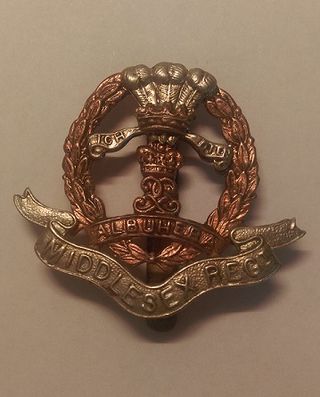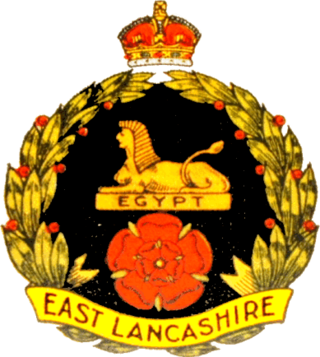Related Research Articles

The South Lancashire Regiment was a line infantry regiment of the British Army in existence from 1881 to 1958.

The King's Shropshire Light Infantry (KSLI) was a light infantry regiment of the British Army, formed in the Childers Reforms of 1881, but with antecedents dating back to 1755. It served in the Second Boer War, World War I, World War II and Korean War. In 1968, the four regiments of the Light Infantry Brigade amalgamated to form The Light Infantry, with the 1st KSLI being redesignated as the 3rd Battalion of the new regiment.

The Middlesex Regiment (Duke of Cambridge's Own) was a line infantry regiment of the British Army in existence from 1881 until 1966. The regiment was formed, as the Duke of Cambridge's Own (Middlesex Regiment), in 1881 as part of the Childers Reforms when the 57th (West Middlesex) and 77th (East Middlesex) Regiments of Foot were amalgamated with the county's militia and rifle volunteer units.

The East Lancashire Regiment was, from 1881 to 1958, a line infantry regiment of the British Army. The regiment was formed in 1881 under the Childers Reforms by the amalgamation of the 30th (Cambridgeshire) Regiment of Foot and 59th Regiment of Foot with the militia and rifle volunteer units of eastern Lancashire. In 1958 the regiment was amalgamated with the South Lancashire Regiment to form the Lancashire Regiment which was, in 1970, merged with the Loyal Regiment to form the Queen's Lancashire Regiment. In 2006, the Queen's Lancashire was further amalgamated with the King's Own Royal Border Regiment and the King's Regiment to form the present Duke of Lancaster's Regiment.

The King's Own Royal Regiment (Lancaster) was a line infantry regiment of the British Army. It served under various titles and fought in many wars and conflicts, including both the First and the Second World Wars, from 1680 to 1959. In 1959, the regiment was amalgamated with the Border Regiment to form the King's Own Royal Border Regiment.

The Border Regiment was a line infantry regiment of the British Army, which was formed in 1881 under the Childers Reforms by the amalgamation of the 34th (Cumberland) Regiment of Foot and the 55th (Westmorland) Regiment of Foot.

The Highland Cyclist Battalion was a bicycle infantry battalion of the Territorial Force, part of the British Army. Formed as part of the Volunteer Force in 1860, it became a Volunteer Battalion of the Black Watch in 1881. In 1909 it became an independent unit and served in the United Kingdom throughout the First World War. In 1920 it was converted as part of the Highland Divisional Signals.
The Lancashire Militia was an auxiliary military force in Lancashire in North West England. From their formal organisation as Trained Bands in 1558 and their service in the Williamite War in Ireland and against the Jacobite Risings, the Militia regiments of Lancashire served during times of international tension and all of Britain's major wars. They provided internal security and home defence but sometimes operated further afield, including Ireland and the Mediterranean, relieving regular troops from routine garrison duties, and acting as a source of trained officers and men for the Regular Army. All the infantry battalions went on active service during the Second Boer War and all served as Special Reserve training units in World War I, with one battalion seeing considerable action on the Western Front. After 1921 the militia had only a shadowy existence until its final abolition in 1953.
The 4th Royal Lancashire Militia (The Duke of Lancaster's Own Light Infantry) was an auxiliary regiment raised in the county of Lancashire in North West England just before the Crimean War. It later became part of the South Lancashire Regiment. Although primarily intended for home defence, it saw considerable active service during the Second Boer War. After conversion to the Special Reserve (SR) under the Haldane Reforms it supplied reinforcements to the fighting battalions during World War I and carried out internal security duties in Ireland. After a shadowy postwar existence the unit was finally disbanded in 1953.
References
- 1 2 3 4 5 6 7 Frederick, pp. 118–21.
- 1 2 3 Hay, pp. 242–8.
- ↑ Parkyn p.228
- ↑ "4th (Militia) Battalion, The King's Own (Royal Lancaster Regiment)". Archived from the original on 9 June 2007. Retrieved 3 December 2020.
- 1 2 Westlake p143
- 1 2 "5th Battalion, The King's Own Royal Regiment [and north Lancashire infantry successors]". Archived from the original on 31 December 2006. Retrieved 3 December 2020.
- ↑ "Unit History: King's Own Royal Regiment" . Retrieved 3 December 2020.
- ↑ James, pp. 45–6.
- ↑ Westlake, Ray (2020). Guide to the Volunteer Training Corps 1914-1918. Uckfield: Naval and Military Press. pp. 4–7. ISBN 9781783315390.
- 1 2 3 4 "King's Own (Royal Lancaster Regiment)" . Retrieved 3 December 2020.
- ↑ Westlake pp. 120-121
- ↑ "The Home Guard and the Defence of Lancaster" . Retrieved 4 December 2020.
- 1 2 Whittaker pp. 118-119
- ↑ Whittaker p. 23
- ↑ "7th Battalion, King's Own Royal Regiment, Lancaster" . Retrieved 4 December 2020.
- ↑ "2nd Battalion, King's Own Royal Regiment, Lancaster" . Retrieved 4 December 2020.
- ↑ "5th Battalion, King's Own Royal Regiment, Lancaster" . Retrieved 4 December 2020.
- ↑ "6th Battalion, King's Own Royal Regiment, Lancaster" . Retrieved 4 December 2020.
- ↑ "7th Battalion, King's Own Royal Regiment, Lancaster" . Retrieved 4 December 2020.
- ↑ "8th Battalion, King's Own Royal Regiment, Lancaster" . Retrieved 4 December 2020.
- ↑ "9th Battalion, King's Own Royal Regiment, Lancaster" . Retrieved 4 December 2020.
- 1 2 "10th Battalion, King's Own Royal Regiment, Lancaster" . Retrieved 4 December 2020.
- ↑ "History of the Home Guard" . Retrieved 18 October 2015.
- ↑ "1st Battalion, 4th Regiment of Foot 1680-1881 / 1st Battalion, The King's Own Royal Regiment 1881-1959". Archived from the original on 23 February 2007. Retrieved 4 December 2020.
- ↑ "2nd Battalion, 4th Regiment of Foot 1799-1802, 1804-15, 1857-81 / 2nd Battalion, The King's Own Royal Regiment 1881-1949". regiments.org. Archived from the original on 1 March 2007. Retrieved 4 December 2020.
Bibliography
- J.B.M. Frederick, Lineage Book of British Land Forces 1660–1978, Vol I, Wakefield: Microform Academic, 1984, ISBN 1-85117-007-3.
- Col George Jackson Hay, An Epitomized History of the Militia (The Constitutional Force), London:United Service Gazette, 1905/Ray Westlake Military Books, 1987 ISBN 0-9508530-7-0.
- Brig E.A. James, British Regiments 1914–18, Samson Books 1978/Uckfield: Naval & Military Press, 2001, ISBN 978-1-84342-197-9.
- H.G. Parkyn, 'English Militia Regiments 1757–1935: Their Badges and Buttons', Journal of the Society for Army Historical Research, Vol 15, No 60 (Winter 1936), pp. 216–248.
- Ray Westlake, Tracing the Rifle Volunteers: A Guide for Military and Family Historians, Barnsley: Pen and Sword, 2010, ISBN 978-1-84884-211-3.